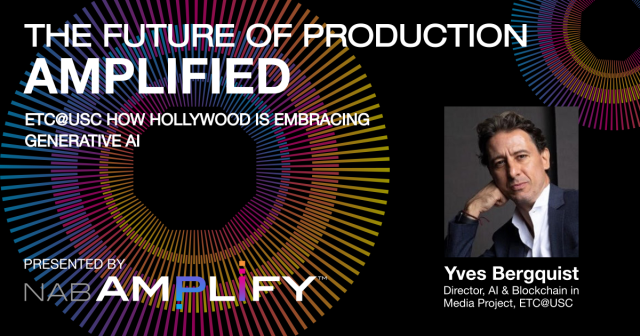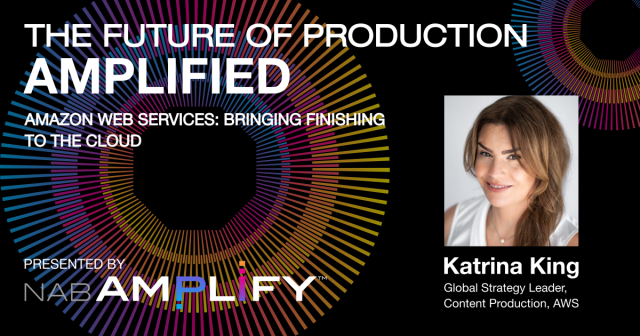
TL;DR
- Yves Bergquist, Director of the AI & Blockchain in Media Project at ETC@USC, discusses generative AI, how it’s being used, and what it could mean for the future of film and television production.
- Generative AI has the power to automate the creative process, allowing for the production of high-quality content at an unprecedented rate, and can be used as a creative assistant for storyboarding, look book schematics, and even how projects are pitched.
- Generative AI is being seriously explored and developed in the pre-production to post-production process, and Bergquist predicts that it will radically transform virtual production and in-camera visual effects.
- The transformation generative AI represents in the M&E industry is enormous, and while it will enhance the creative process, it’s a new language that creatives need to learn to speak.
Videos in “The Future of Production Amplified” Series:
- The Future of Production Amplified: How Real-Time Graphics Are Changing the Face of Film and Television Production
- The Future of Production Amplified: Pushing the Limits of Virtual Production
- The Future of Production Amplified: Bringing Digital Humans into the Spotlight
- The Future of Production Amplified: Bringing Finishing to the Cloud
- The Future of Production Amplified: Delivering Broadcast-Quality Graphics to Creators Everywhere
- The Future of Production Amplified: ETC@USC Takes Virtual Production into the Cloud with “Fathead”
- The Future of Production Amplified: How Open Source Is Taking Hollywood by Storm
- The Future of Production Amplified: Defining a New Production Ecosystem with MovieLabs
- The Future of Production Amplified: Moving Middle Earth to the Cloud with “The Lord of the Rings: The Rings of Power”
Generative AI has quickly become one of the most talked-about technologies in the Media & Entertainment industry, and for good reason. This groundbreaking technology has the power to automate the creative process, allowing for the production of high-quality content at an unprecedented rate. From video games to feature films, generative AI is revolutionizing the way content is created. However, while it can speed up production and open up new creative possibilities, it’s not a replacement for human creativity and intuition. To unlock the full potential of generative AI, and stay ahead of the wave that is transforming the M&E landscape, industry professionals must understand not only its capabilities but also its limitations.
As part of our series, “The Future of Production Amplified,” NAB Amplify content partner Jennifer Wolfe chats with Yves Bergquist, Director of the AI & Blockchain in Media Project at the Entertainment Technology Center at the University of Southern California, or ETC@USC, about generative AI, how it’s being used, and what it could mean for the future of film and television production.
Bergquist brings deep experience as an AI researcher to his role at ETC@USC, where he and his team use frontier AI methods to help media companies develop insights into their content, their audiences, and the cognitive relationship between the two. In addition, Bergquist is a member of the Digital Storytelling Lab at Columbia University’s School of the Arts, and the co-chair of SMPTE’s Joint Task Force on Artificial Intelligence Standards in Media, where he helps drive the standardization of AI methods throughout the media industry.
We should think of generative AI as a creative assistant, Bergquist suggests, noting that the burgeoning technology will be most disruptive to the pre-production phase, revolutionizing storyboarding, look book schematics, and even how projects are pitched. “You can literally create a very sophisticated first draft of your of your film or TV show” now with generative AI, he says.
Virtual production and in-camera visual effects will also be radically transformed through the use of neural radiance fields, he predicts. “That is a little bit further out because it’s a little bit more technically sophisticated, but definitely coming and massively disruptive for post-production, where a whole bunch of workflows that used to take weeks can now take just a few minutes or hours.”
In Part 1 of this exclusive Q&A, Bergquist covers the basics of generative AI — what it is and what it isn’t, and the kind of work it performs best. He also talks about the radical impact it’s having on the Media & Entertainment industry, walking us through the various stages of the content creation value chain, and how the true disruption is the increase in production value available to content creators of all levels, from filmmakers and showrunners to TikTok influencers.
Watch Part 1 below:
In Part 2, Bergquist dives into the various ways independent filmmakers and studios are using generative AI. “We’re at a point where the experimentation phase is ending and the actual use of these methods in the pre-production to post-production process is being seriously explored and developed,” he says.
Bergquist also discusses the disruptive potential of generative AI on marketing and SEO. “We’ve seen a pretty extraordinary capability of generative AI to output entire websites, create entire blog posts,” he observes. “The SEO game is all about volume, and so the ability to create an enormous volume of blog posts, website content, just general internet content at the push of a button is extremely disruptive for the SEO industry.”
Watch Part 2 below:
In Part 3, Bergquist shares what he sees for the future of generative AI, naming the winners and losers inside this new ecosystem. “There is no future where AI doesn’t destroy jobs,” he comments, noting that the transformation generative AI represents in the M&E industry is enormous. “Twelve months, 18 months from now, we’ll probably look at a VFX workflow that is pretty radically different than what it is today.”
To prepare themselves, Bergquist says, creatives need to educate themselves in the new technology as much as possible. “Embrace it, dive into it, try it. You know, become expert at it in the same manner that text processing and word processing took over from typewriters. This is a new set of tools that will enhance the creative process. But it’s a new language and you have to learn how to speak it.”
Watch Part 3 below:
You can connect with Yves Bergquist on LinkedIn or follow him on Instagram and Twitter. You can also follow ETC@USC on Facebook, LinkedIn and Twitter, and learn more about the organization and its mission at www.etcenter.org.
DISCOVER THE FUTURE OF PRODUCTION AMPLIFIED:
Take a peek into The Future of Production Amplified with NAB Amplify’s series featuring top creatives and other M&E professionals helping to shape the future of film and television production. Gain insights into the latest trends in virtual production, cloud-based workflows, real-time graphics, live production, digital humans and other cutting-edge technologies as we chat with industry experts from AWS, Epic Games, Digital Domain, and more!
- The Future of Production Amplified: How Real-Time Graphics Are Changing the Face of Film and Television Production
- The Future of Production Amplified: Bringing Digital Humans into the Spotlight
- The Future of Production Amplified: Pushing the Limits of Virtual Production
- The Future of Production Amplified: Bringing Finishing to the Cloud
- The Future of Production Amplified: Delivering Broadcast-Quality Graphics to Creators Everywhere
- The Future of Production Amplified: ETC@USC Takes Virtual Production into the Cloud with “Fathead”
- The Future of Production Amplified: How Open Source Is Taking Hollywood by Storm
- The Future of Production Amplified: Defining a New Production Ecosystem with MovieLabs
- The Future of Production Amplified: Moving Middle Earth to the Cloud with “The Lord of the Rings: The Rings of Power”



